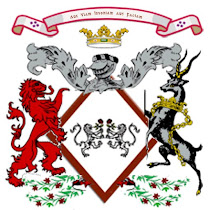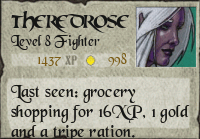Og-Mhadainn! (h'og maidne) - Scots Gælic for New Morning
I find myself very reflective this morning as I look into the face of a New Year. I think of the past year; of my wonderful family; of new friends made; of old friends even more deeply loved; of sadness; of joy.
However, I also find myself thinking about the traditions - some ancient, some more recent - that have brought us as a human culture to this place of celebration and reminiscence. Please allow me to delve briefly into a few of these things with you even as I celebrate my lives (the first and the second) within the course of this post. I shall do my best to weave a thread through all of it, which will bring the circle together by the time we reach the end.
Because I am who I am, we must start with the Scots. My People. And so we begin with a discussion of Hogmanay.
Hogmanay (pronounced [ˌhɔgməˈneː] — with the main stress on the last syllable - hug-m'NAY) is the Scots word for the last day of the year and is synonymous with the celebration of the New Year (Gregorian calendar) in the Scottish manner. Its official date is December 31st (Auld Year's Night). However this is normally only the start of a celebration which lasts through the night until the morning of Ne'erday (January 1st).
Most believe that Hogmanay has roots in the winter solstice celebrations of the Norse and the Gælic celebration of Samhain. This winter festival went underground for many years as the Protestant Revolution took place in Scotland since the Presbyterian Church disapproved of Hogmanay. However, in the 17th century as the church relaxed it's views on this custom, Hogmanay celebrations were revived.
There are many customs, both national and local, associated with Hogmanay. The most widespread national custom is the practice of "first footing" which starts immediately after midnight. This involves being the first person to cross the threshold of a friend or neighbour and often involves the giving of symbolic gifts such as salt, coal, shortbread, or whisky - each intended to bring different kinds of luck to the householder. Food and drink (as the gifts) are then given to the guests. This may go on throughout the early hours of the morning and well into the next day. The first-foot is supposed to set the luck for the rest of the year, so it is important that a suitable person does the job. A tall, handsome, and dark-haired man bearing a gift is strongly preferred. According to popular folklore, a man with dark hair was welcomed because he was assumed to be a fellow Scotsman; a blond or red-haired stranger was assumed to be an unwelcome Norseman (of course the three of you are always welcome, Sir Tele, Colonel O'Toole, and Professor Krogstad).
So if you will be satisfied with a rather petite, fairly attractive, dark-haired woman bearing gifts of whisky and shortbread, please allow me to virtually cross your thresholds as a "first-footer" for I wish you all very well and a most prosperous and healthy New Year.
One other tradition that I shall hope to bring to SL next year is (the very appropriate) burning of the clavie. Burning the clavie is an ancient Scottish custom . The clavie is a bonfire of casks split in two. One of these casks is joined together again by a huge nail (Latin clavis; hence the term, it may also be from the Scots-Gælic, cliabh, a basket used for holding combustibles). It is then filled with tar, lighted and carried flaming round the village and finally up to an alter. It here forms the nucleus of the bonfire, which is built up of split casks. When the burning tar-barrel falls in pieces, the people scramble to get a lighted piece with which to kindle the New Year's fire on their cottage hearth. The charcoal of the clavie is collected and put in pieces up the cottage chimneys, to keep spirits and witches from coming down.
Jan1984.jpg)
Jan1984.jpg)
There are so many traditions in this world for the celebration of a new year, that I could certainly fill an entire volume (or two) for the Proceedings of the Royal Society were I to do them any justice at all, so I shall simply mention a few of them with little detail at this time. (This is in NO WAY a complete list.) However, it is important recognize distinct traditions of others that we never become isolated in our own small corner(s) of this magnificent metaverse (universe).
Most cultures that measure time on a yearly calendar do, in fact, celebrate the changing of the year.
Here are a few examples:
January 1 - The first official day of the year in the Gregorian calendar used by most countries
January 14 - Eastern Orthodox Church - recognizes as the civil new year (January 1 on the Julian Calendar), and September 1 is the liturgical new year.
January 21-February 21 (varies) - Chinese or Lunar New Year
Norouz - This Iranian new year celebration falls at the Vernal Equinox
Gudi Padwa - Hindi new year falls in March or April
Punjabi new year - falls on April 13th and celebrates the harvest
Rosh Hashanah (Hebrew for 'head of the year') is a holiday commemorating the culmination of the seven days of creation and marking God's yearly renewal of His world. The day has elements of festivity and introspection, as God is traditionally believed to be assessing His creation and determining the fate of all men and creatures for the coming year.
Samhain (a festival of the ancient Celts, held around November 1) as a new year's day representing the new cycle of the Wheel of the Year, although they do not use a different calendar that starts on this day.

On more personal notes, it has been a pleasure (with a few exceptions - as SL and RL are neither one Utopia) to be among you over this last year. My circles of friends has grown, and a few friendships have deepened and become more meaningful. I have learned more about myself and about some of you. We have grown as a community and have extended ourselves as a community to reach out to others: Steelhead and Winterfell most specifically. We have explored new places, created stories for ourselves, created new objects and other projects, raised funds to assist those in real life danger (one needs only search on this blog alone for Relay for Life, or BoobieThon to see many articles providing evidence for these efforts), and had many happy times together.

Around midnight, I left the Gaity and traveled to Carntaigh to be with other friends who had already escaped the lag of the crowded halls in Penzance.

His Grace of Murdann provided some fireworks for us as the clock struck Midnight for those of us celebrating the East Coast of the US New Year.

Apparently the gowns were not flammable - thank heavens! LordAlbert Heron and Miss Edwina Heron proved to be most excellent and gracious hosts in Her Grace Carntaigh's absence (she was still in Penzance).
Real life has also been good. My family is healthy and happy and brings me joy. New friends and old have added exponentially to my life. I have enjoyed travel to places from New York City to Tidewater, Virginia; from Lancaster and Gettysburg to Manchester and Helsinki. I have sung. I have laughed. I have cried. I have enjoyed food and drink, literature and movies. I have taken quiet walks and wrestled in the floor with my giggling children. I have counseled troubled friends, and been comforted in my own sadness by those who love me.
My life (lives) is very good. I am a fortunate woman - there can be no denial of this. I love and am loved in return.
And with these thoughts placing a smile on my face, I take the last sip of my coffee and head off to RL to play with my beautiful children.
Slàinte mhath, mo charaids!










2 comments:
Burning things does seem to have a universal appeal, doesn't it? On Sunday the 27th inst., I will be celebrating a similar Scottish holiday, although this one honors the Viking heritage of Shetland. Up Helly Aa features a burning longboat, as well as the processions and carousing typical of such celebrations. There will be opportunity for groups ("squads") to compete with skits or costume themes.
Excellent, Murdann! I can hardly wait!
Now where might I find some folks who would act a skit with me?
Post a Comment